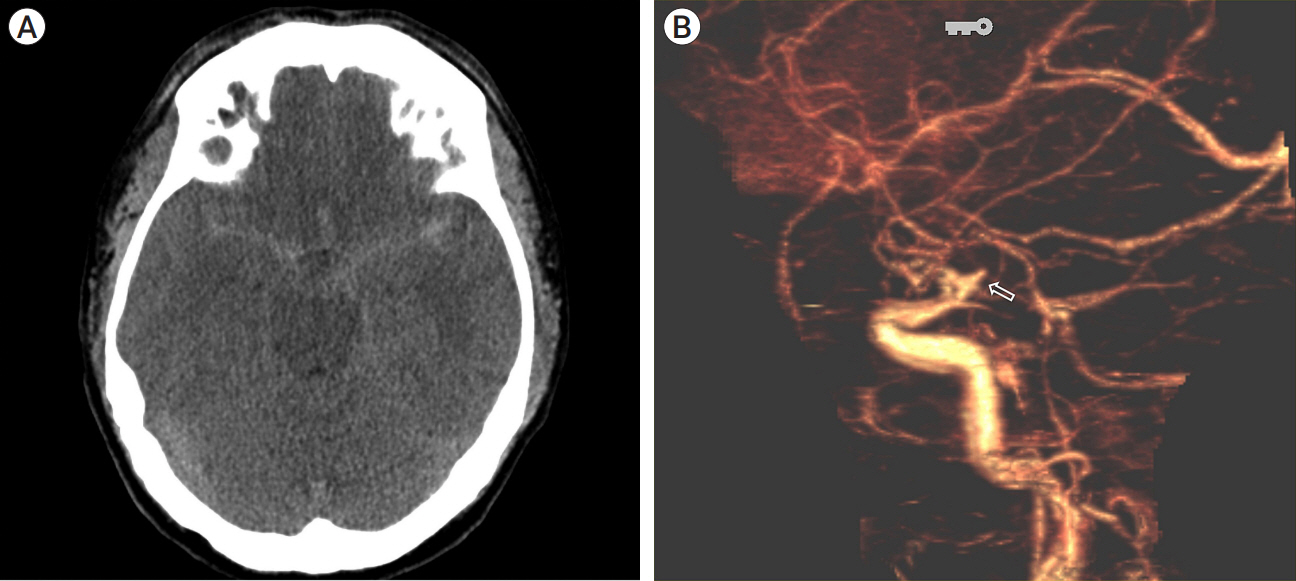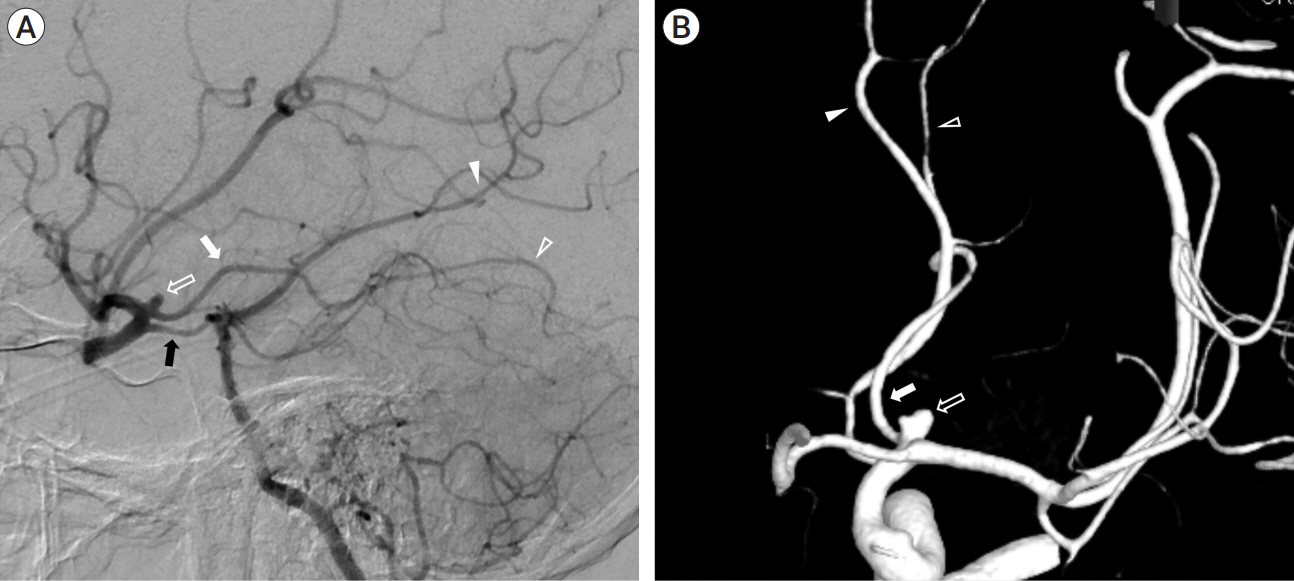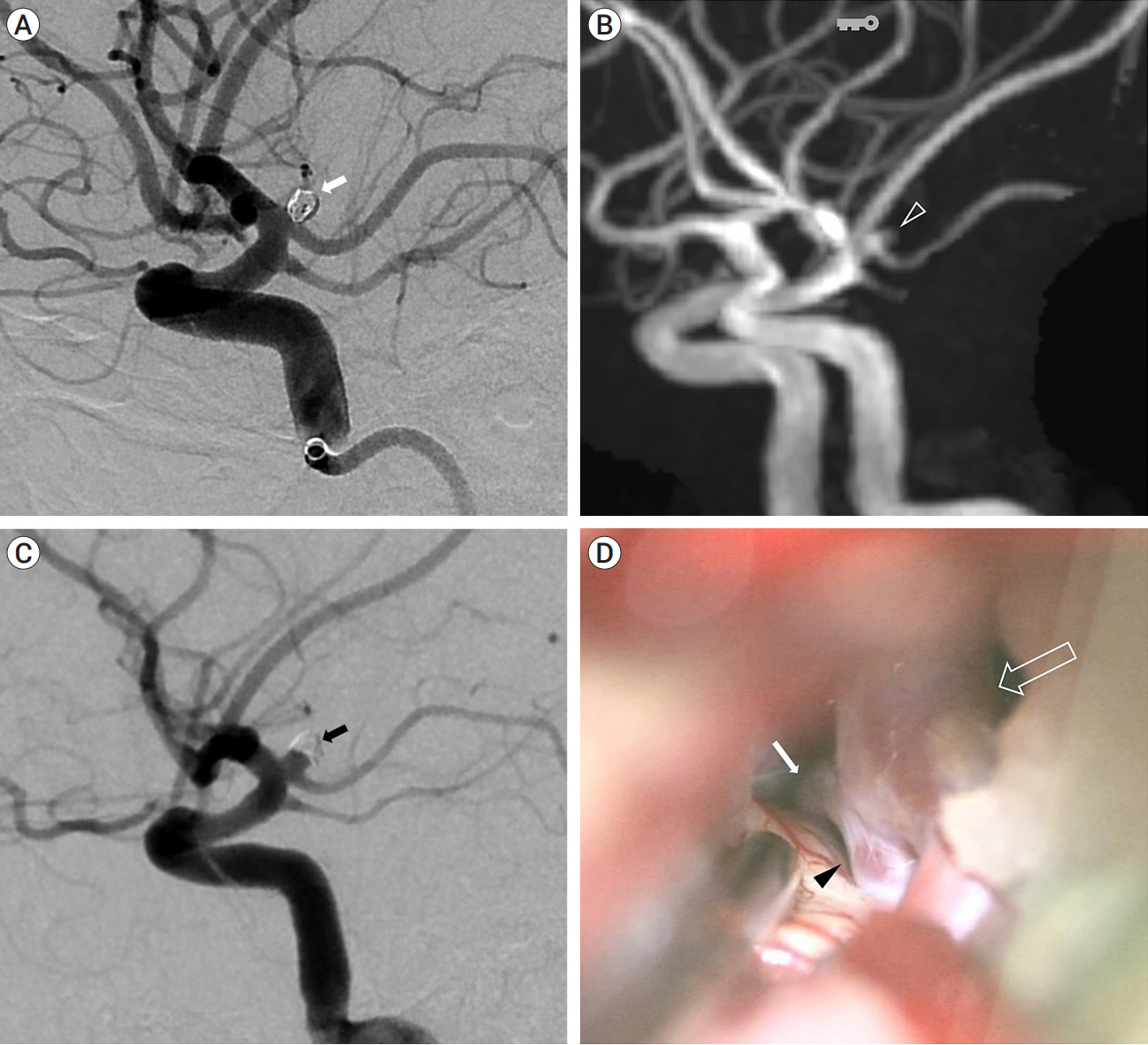J Cerebrovasc Endovasc Neurosurg.
2024 Jun;26(2):181-186. 10.7461/jcen.2023.E2023.08.003.
Coil embolization and recurrence of ruptured aneurysm originating from hyperplastic anterior choroidal artery
- Affiliations
-
- 1Department of Neurosurgery, Yonsei University, Severance Hospital, Seoul, Korea
- 2Department of Neurosurgery, Gangnam Sevrance Hospital, Yonsei University College of Medicine, Seoul, Korea
- 3Department of Neurosurgery, Uijeongbu St. Mary’s Hospital, Uijeongbu, Gyeonggi-do, Korea
- KMID: 2556980
- DOI: http://doi.org/10.7461/jcen.2023.E2023.08.003
Abstract
- Hyperplastic anterior choroidal artery (AchA) is an extremely rare congenital vascular variant that can be mistaken for other cerebral arteries. This case report presents a 38-year-old man who presented with a severe sudden-onset headache and was diagnosed with a ruptured aneurysm originating from a hyperplastic AchA. The aneurysm was successfully treated with coil embolization, but recurrence was detected after eight months, leading to additional surgical intervention. The discussion highlights the classification of hyperplastic AchA and emphasizes the importance of recognizing this anatomical variant to avoid complications during treatment. This case report underscores the need for awareness and understanding of hyperplastic AchA in the management of cerebral aneurysms.
Keyword
Figure
Reference
-
1. Abrahams JM, Hurst RW, Bagley LJ, Zager EL. Anterior choroidal artery supply to the posterior cerebral artery distribution: Embryological basis and clinical implications. Neurosurgery. 1999; Jun. 44(6):1308–14.
Article2. Blackburn IW. Anomalies of the encephalic arteries among the insane. A study of the arteries at the base of the encephallon in two hundred and twenty consecutive cases of mental disease, with special reference to anomalies of the circle of Willis. Journal of Comparative and Psychology. 1907; Nov. 17(6):493–517.
Article3. Campi A, Ramzi N, Molyneux AJ, Summers PE, Kerr RS, Sneade M, et al. Retreatment of ruptured cerebral aneurysms in patients randomized by coiling or clipping in the International Subarachnoid Aneurysm Trial (ISAT). Stroke. 2007; May. 38(5):1538–44.
Article4. Choi DS, Kim MC, Lee SK, Willinsky RA, Terbrugge KG. Clinical and angiographic long-term follow-up of completely coiled intracranial aneurysms using endovascular technique. J Neurosurg. 2010; Mar. 112(3):575–81.
Article5. Choi HH, Cho YD, Yoo DH, Lee HS, Kim SH, Jang D, et al. Impact of fetal-type posterior cerebral artery on recanalization of posterior communicating artery aneurysms after coil embolization: Matched-pair case–control study. J Neurointerv Surg. 2020; Aug. 12(8):783–7.
Article6. Cognard C, Weill A, Spelle L, Piotin M, Castaings L, Rey A, et al. Long-term angiographic follow-up of 169 intracranial berry aneurysms occluded with detachable coils. Radiology. 1999; Aug. 212(2):348–56.
Article7. Doi K, Mizuno T, Shigematsu Y, Kobayashi O, Takezaki T, Muta D, et al. A new type of hyperplastic anterior choroidal artery. J Clin Neurosci. 2018; May. 51:72–4.
Article8. Gaba RC, Ansari SA, Roy SS, Marden FA, Viana MA, Malisch TW. Embolization of intracranial aneurysms with hydrogel-coated coils versus inert platinum coils: Effects on packing density, coil length and quantity, procedure performance, cost, length of hospital stay, and durability of therapy. Stroke. 2006; Jun. 37(6):1443–50.
Article9. Hahm MH, Moon S. Anomalous hyperplastic anterior choroidal artery and its mimicker: A case series. Surg Radiol Anat. 2021; Dec. 43(12):1961–5.
Article10. Hyun DK, Shim YS, Park HS, Oh SY. Thromboembolic complication following neurointervention in ruptured anomalous hyperplastic anterior choroidal artery aneurysm. Neuroradiol J. 2014; Feb. 27(1):103–7.
Article11. Iihoshi S, Nonaka T, Miyata K, Houkin K. Angiographic analysis of variations and anomalous origin of the anterior choroidal artery and posterior communicating artery. No Shinkei Geka. 2010; 38(6):523–30.12. Jeon JP, Cho YD, Yoo DH, Moon J, Lee J, Cho WS, et al. Risk factor analysis of recanalization timing in coiled aneurysms: Early versus late recanalization. AJNR Am J Neuroradiol. 2017; Sep. 38(9):1765–70.
Article13. Kang HS, Kwon BJ, Kwon OK, Jung C, Kim JE, Oh CW, et al. Endovascular coil embolization of anterior choroidal artery aneurysms. Clinical article. J Neurosurg. 2009; Nov. 111(5):963–9.14. Kim MJ, Chung J, Park KY, Kim DJ, Kim BM, Suh SH, et al. Recurrence and risk factors of posterior communicating artery aneurysms after endovascular treatment. Acta Neurochir (Wien). 2021; Aug. 163(8):2319–26.
Article15. Koyanagi M, Ishii A, Imamura H, Satow T, Yoshida K, Hasegawa H, et al. Long-term outcomes of coil embolization of unruptured intracranial aneurysms. J Neurosurg. 2018; Dec. 129(6):1492–8.
Article16. Lee HJ, Choi JH, Shin YS, Lee KS, Kim BS. Risk factors for the recurrence of posterior communicating artery aneurysm: The significance of fetal-type posterior cerebral artery. J Stroke Cerebrovasc Dis. 2021; Jul. 30(7):105821.
Article17. Mascitelli JR, Moyle H, Oermann EK, Polykarpou MF, Patel AA, Doshi AH, et al. An update to the Raymond-Roy Occlusion Classification of intracranial aneurysms treated with coil embolization. J Neurointerv Surg. 2015; Jul. 7(7):496–502.
Article18. Matsumoto K, Akagi K, Abekura M, Ohkawa M, Tasaki O, Oshino S. Cerebral aneurysm associated with an anomalous hyperplastic anterior choroidal artery. Acta Neurochir (Wien). 2000; 142(3):347–50.
Article19. Mehra M, Hurley MC, Gounis MJ, King RM, Shaibani A, Dabus G, et al. The impact of coil shape design on angiographic occlusion, packing density and coil mass uniformity in aneurysm embolization: An in vitro study. J Neurointerv Surg. 2011; Jun. 3(2):131–6.
Article20. Mitsuhashi T, Oishi H, Teranishi K, Kodama T, Kudo K, Tokugawa J, et al. Ruptured anomalous hyperplastic anterior choroidal artery aneurysm: A case report. Br J Neurosurg. 2019; Jun. 37(3):296–7.
Article21. Okazaki T, Shibukawa M, Kiura Y, Sakamoto S, Ichinose N, Eguchi K, et al. Endovascular coil embolization for ruptured aneurysm associated with persistent primitive anterior choroidal artery--Case report. Neurol Med Chir (Tokyo). 2011; 51(2):127–9.22. Plowman RS, Clarke A, Clarke M, Byrne JV. Sixteen-year single-surgeon experience with coil embolization for ruptured intracranial aneurysms: Recurrence rates and incidence of late rebleeding. Clinical article. J Neurosurg. 2011; Mar. 114(3):863–74.23. Raymond J, Guilbert F, Weill A, Georganos SA, Juravsky L, Lambert A, et al. Long-term angiographic recurrences after selective endovascular treatment of aneurysms with detachable coils. Stroke. 2003; Jun. 34(6):1398–403.
Article24. Fujii K, Fradd B. Microsurgical anatomy of the anterior choroidal artery. Surg Neurol. 1979; Aug. 12(2):171–87.25. Roy D, Milot G, Raymond J. Endovascular treatment of unruptured aneurysms. Stroke. 2001; Sep. 32(9):1998–2004.
Article26. Rusu MC, Vrapciu AD, Lazar M. A rare variant of accessory posterior cerebral artery. Surg Radiol Anat. 2023; May. 45(5):523–6.
Article27. Rutledge C, Jonzzon S, Andrew Winkler E, Hetts SW, Abla AA. Transcortical transventricular transchoroidal-fissure approach to distal fusiform hyperplastic anterior choroidal artery aneurysms. Br J Neurosurg. 2019; Aug. 37(4):723–7.
Article28. Shah AU, Joshi AR, Rai PR, Kapse P. Hyperplastic anterior choroidal artery-A rare variant detected on MR angiography. Indian J Radiol Imaging. 2022; Jun. 32(2):266–9.
Article29. Shioya H, Kikuchi K, Suda Y, Shoji H, Shindo K. Ruptured internal carotid -posterior communicating artery aneurysm associated with an anomalous hyperplastic anterior choroidal artery and aneurysm: Case report. No Shinkei Geka. 2005; Feb. 33(2):155–62.30. Takahashi S, Suga T, Kawata Y, Sakamoto K. Anterior choroidal artery: Angiographic analysis of variations and anomalies. AJNR Am J Neuroradiol. 1990; Jul-Aug. 11(4):719–29.31. Tian Z, Liu J, Zhang Y, Zhang Y, Zhang X, Zhang H, et al. Risk factors of angiographic recurrence after endovascular coil embolization of intracranial saccular aneurysms: A retrospective study using a multicenter database. Front Neurol. 2020; Sep. 11:1026.
Article
- Full Text Links
- Actions
-
Cited
- CITED
-
- Close
- Share
- Similar articles
-
- Treatment results of anterior choroidal artery aneurysms treated mostly with coil embolization: A single-center experience
- Coil Embolization of Aneurysm Followed by Stereotactic Aspiration of Hematoma in a Patient with Anterior Communicating Artery Aneurysm Presenting with SAH and ICH
- Spontaneous Occluded Anterior Communicating Artery Aneurysm during Coil Embolization Treated with One Coil Insertion into Remaining Stump
- Endovascular Coil Embolization After Clipping: Endovascular Treatment of Incompletely Clipped or Recurred Cerebral Aneurysms
- Technical Approaches for Coil Embolization of Unruptured Small Anterior Choroidal Artery Aneurysms: A Focus on Anatomical Flow Preservation of the Anterior Choroidal Artery




